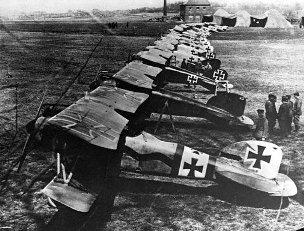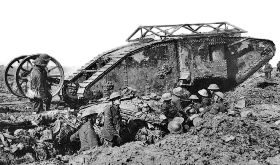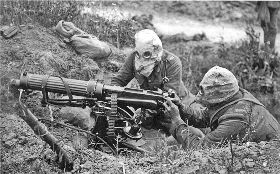World War I
Changes in Modern Warfare
World War I introduced many advances in science and technology into modern warfare. These advances changed the nature of warfare including battle strategies and tactics. Scientists and inventors on both sides worked throughout the war to improve weapon technology in order to give their side an edge in the fight. War in the Air
World War I was the first war where the airplane was used. Initially, airplanes were used to observe enemy troops. However, by the end of the war they were used to drop bombs on troops and cities. They also had mounted machine guns that were used to shoot down other planes.

German fighter planes
Tanks
Tanks were first introduced in World War I. These armored vehicles were used to cross "No Man's Land" between the trenches. They had mounted machine guns and cannon. The first tanks were unreliable and hard to steer, however, they became more effective by the end of the war.

A tank during the Battle of the Somme
Trench Warfare
Much of the war along the western front was fought using trench warfare. Both sides dug long lines of trenches that helped to protect the soldiers from gunfire and artillery. The area between enemy trenches was called No Man's Land. Trench warfare caused a stalemate between the two sides for many years. Neither side gained ground, but both sides lost millions of soldiers.
Changes in Naval Warfare
The most dangerous ships during World War I were large metal-armored battleships called dreadnoughts. These ships had powerful long-range guns, allowing them to attack other ships and land targets from a long distance. The main naval battle in World War I was the Battle of Jutland. Besides this battle, Allied naval ships were used to blockade Germany to prevent supplies and food from reaching the country.
World War I also introduced submarines as a naval weapon in warfare. Germany used submarines to sneak up on ships and sink them with torpedoes. They even attacked Allied passenger ships such as the Lusitania.
New Weapons
- Artillery - Large guns, called artillery, were improved during World War I including anti-aircraft guns to shoot down enemy planes. The majority of the casualties in the war were inflicted using artillery. Some large artillery guns could launch shells nearly 80 miles.
- Machine gun - The machine gun was improved during the war. It was made much lighter and easier to move around.
- Flame throwers - Flame throwers were used by the German Army on the western front in order to force the enemy out of their trenches.
- Chemical weapons - World War I also introduced chemical weapons to warfare. Germany first used chlorine gas to poison unsuspecting Allied troops. Later, the more dangerous mustard gas was developed and used by both sides. By the end of the war, troops were equipped with gas masks and the weapon was less effective.

Soldiers in gas masks firing a machine gun
- Tanks were initially called "landships" by the British. They later changed the name to tank, which was what the factory workers called them because they looked like a large water tank.
- The main form of transportation of troops during the war was the railroad. Armies would build new railroads as they advanced.
- British soldiers in the trenches used a bolt-action rifle. They could fire around 15 shots in a minute.
- Large artillery guns needed as many as 12 men to aim, load, and fire them.
Technological Developments (4.00)
WWI Firsts (2.00)
Comment on the blog and tell us one fact that you learned from EACH of the three videos.
Something I learned from the airplane video is that the pilots took shots with pistols at each other before guns were able to be mounted on the planes. I learned from the Tech Developments video that the Canadian soldiers were the first army to be attacked by a gas attack and that they were totally unprepared for it. It was interesting but sad how chlorine gas kills people. I learned from the Firsts video that the Germans only had 20 tanks. For some reason, I thought that Germany was a tank powerhouse and that they had tons of them. I didn't learn anything from the fourth video because it was the same link as the third video.
ReplyDeleteThanks Jacob, I removed the extra video and changed the directions to comment on the THREE videos. :)
Delete:)
DeleteI agree with Jacob; I thought that was really sad that the Canadians were the first ones to be attacked by the chlorine gas and they were not prepared at all for it.
DeleteI am impressed that airplane improved in such a short amount of time. What started as the flimsy Bleriot XI crossing the Atlantic ocean it improved for war with the Sopwith Triplane in 1916. I learned that the first gas attack was at Vimy Ridge in France. WWI was the first time american solders had to take IQ tests, I wonder why they did not do that before.
ReplyDeleteFrom the first video I learned about the gas attack. I had no idea that gas could fill your lungs with liquid and allow you to "drown from the inside out" yuck! From the 2nd video I was suprises that the number of tanks were so different! One country has over 3000 and the next has 20. I thought each country would have at least close to an equal amount of tanks.
ReplyDeleteWow, it is amazing that the gases have an affect on the solders simulating drowning. On the WWI Weapons worksheet it says that it smelled like a mix of pineapple and pepper before "drowning".
DeleteThis comment has been removed by the author.
DeleteIn the first video i learned alot because i had never really spent time learning about the ariplanes but something i found cool was just how fast they improved them and to what extents, like the gun that only fired when the propellers were not in the way. that was a major improvement! From the second video i learned that they used chlorine gas and how that basically made you drown from the inside out. I learned that WWI had the first aircraft carriers and the different amounts of tanks each country had from the third video.
ReplyDeleteFor the WWI Weapons worksheet, I think I am missing a page. On the questions part of the worksheet, they referenced Zeppelins and Tanks but the previous pages do not reference them.
ReplyDeletei googled it.
DeleteThanks for the idea, to be honest I already knew about zeppelins.
DeleteYeah I couldn't find answers for questions 7, 8, 5, or 10. 7 and 8 go together. I haven't watched the videos yet so that may answer number 10 but the others I can't see anything.
Deletei googled it too
DeleteSomething I learned from the first video was that they engineered the planes to work so that the bullets shot in between the propeller as it was spinning. Something I learned from the Tech Developments video was that General J. Pershing trained his troops to fight in open warfare even though the British and French generals thought he was crazy and they criticized him and his troops. Something I learned from the third video was that Britain had 2636 tanks, France had 3870, the US had less than 100, and Germany only had 20.
ReplyDeleteI learned from the first video that pilots had little pointy metal sticks, flechettes, to drop on people down below. Ouch! That would hurt. "Oh! I'm just going to go to the loo!" *walks outside* *gets stabbed with flechette* "Ow." :)
ReplyDeleteAlso I must say that it was very hard to pay attention when Mr. Blue Sky started playing in the background. I love that song! ELO is so good. Sorry, off topic! For the second video, I learned that gas makes you drown from the inside out. I was almost throwing up myself at that! So gross! And what a terrible way to die. From the last video, I learned that blood banks were created! I thought that was pretty cool. I liked that World War 1 really pushed women to fight for themselves.
I totally agree with you on all of those! And haha that visual is awesome of the flechette. It makes me wonder how painful it is. Or if you can tell when its falling towards you because its so thin and fast!
DeleteFrom video one, i found it so cool that air warfare was first founded in WW1 period! it must have been so gutsy and scary to bring the war to the sky, i can only imagine the first time. 2) A hundred rounds per minute! in a single pull of a trigger using a machine gun. i found that just flat out crazy. 3) from this video, although all the weapons are very intriquing, i found it pretty cool and interesting that the first listed woman was in this war. power to the us girls ;)
ReplyDeletei agree with tanah power to the girls
DeleteThe three facts that stood out to me were, how quickly the plans advanced from being flimsy in 1909 to being able to fly 7 times higher and 2 and a half times faster. The second fact was that chlorine gas makes your longs fill with water, The third fact was how many tanks the French had, which is 3870.
ReplyDeletethe first video, i thought it was funny that the guy didn't want to fly the airplane, the other thing is, some airplanes had guns built in to them and when they shot them they couldn't hit the propeller. the second video, i thought was interesting, but didn't find any thing specific. the third video, that the Americans had 100 and the 2 first one had so many other ones. the last ones had 20 :(:(:(:(
ReplyDeleteWhat I learned in...
ReplyDelete#1. that someone named Louie was the first to cross the English channel in a plane (the Bleriot XI), and that planes were not only used to help fight, but to watch and report on the enemy (spy)
#2. that WWI was the first war where the scientists and war-product producers actually thought of how to make their weapons better, how to improve their country's artillery and army.
#3. I learned that America only had less than 100 tanks in the war!
On the first video I thought it was kinda funny how the pilots used to wave at each other and then started shooting. In the second one it was cool how they could design gases to hurt and drown someone from the inside out. And lastly, the video of firsts. I had no clue that the soldiers were first given iq tests in WWI.
ReplyDeleteon the first video i didnt know that the pilots dropped spikes hoping it would hit the enemy on the second video i didnt know that WWI was the first war to use science in it and for the third video i dint know that WWI had the first steel helments
ReplyDelete1st vid: Airplanes used in war for the first time!
ReplyDeleteI learned that the Bleriot plane could go up to 76 km/h (which is about 47 miles per hour.) That's like a slow freeway! :)
Video 2: Technological Developments
A fact I learned was that a machine gun fires 100s of rounds a minute!
Video 3: WWI Firsts
I learned that WWI gave us the first guide dogs! :D